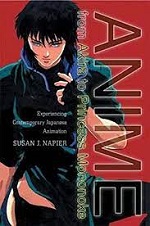libro
Anime from Akira to Princess Mononoke: Experiencing Contemporary Japanese Animation

Napier, Susan J.
Título: Anime from Akira to Princess Mononoke: Experiencing Contemporary Japanese Animation
Autor(es): Susan J. Napier
Publicación: New York : Palgrave, St. Martin's Press, 2001
Idioma: Inglés
Formato: Digital
Resumen: Anime from Akira to Princess Mononoke: Experiencing Contemporary Japanese Animation is a scholarly book which uses techniques of literary criticism on anime by Susan J. Napier published in 2001 by Palgrave Macmillan. It discusses themes of shojo, hentai, mecha, magical girlfriend and magical girl anime using select titles. It also discusses some aspects of the English-speaking anime fandom.
The book uses literary criticism to discuss themes and ideas present in select anime titles and attempts to categorise anime into three types - apocalyptic, festival, and elegiac. The book is split into five sections. In the first, Napier asks why anime is important as a topic of study. In the second, Napier looks at the representation of the human body in anime, looking at "monstrous adolescents", pornographic anime and cyborgs. In the third, Napier looks at representations of females, the girl, the magical girl and magical girlfriends. In the fourth section, Napier examines historical-themed anime. The "monstrous adolescent" is often a quick-tempered or psychologically disturbed child with remarkable and world-changing powers, which were usually a result of scientific experiments, revolutionary technology, or human-caused pollution. These children have the power to improve or alter the world, but because of their personality the child is often on the verge of destroying it completely. The source of this create/destroy idea is usually traced back to the effects of Hiroshima and the capabilities of nuclear power and atomic bombs. The theme of the "monstrous adolescent" explores society's fears of ever-growing technology, the rebellious actions of children, and the apocalyptic scenarios that are suggested by combining these two themes.
Ubicación: 2835-L
Descriptor(es)
1. ANIMÉ
2. CINE JAPONES - ANIMACIÓN
Autor(es): Susan J. Napier
Publicación: New York : Palgrave, St. Martin's Press, 2001
Idioma: Inglés
Formato: Digital
Resumen: Anime from Akira to Princess Mononoke: Experiencing Contemporary Japanese Animation is a scholarly book which uses techniques of literary criticism on anime by Susan J. Napier published in 2001 by Palgrave Macmillan. It discusses themes of shojo, hentai, mecha, magical girlfriend and magical girl anime using select titles. It also discusses some aspects of the English-speaking anime fandom.
The book uses literary criticism to discuss themes and ideas present in select anime titles and attempts to categorise anime into three types - apocalyptic, festival, and elegiac. The book is split into five sections. In the first, Napier asks why anime is important as a topic of study. In the second, Napier looks at the representation of the human body in anime, looking at "monstrous adolescents", pornographic anime and cyborgs. In the third, Napier looks at representations of females, the girl, the magical girl and magical girlfriends. In the fourth section, Napier examines historical-themed anime. The "monstrous adolescent" is often a quick-tempered or psychologically disturbed child with remarkable and world-changing powers, which were usually a result of scientific experiments, revolutionary technology, or human-caused pollution. These children have the power to improve or alter the world, but because of their personality the child is often on the verge of destroying it completely. The source of this create/destroy idea is usually traced back to the effects of Hiroshima and the capabilities of nuclear power and atomic bombs. The theme of the "monstrous adolescent" explores society's fears of ever-growing technology, the rebellious actions of children, and the apocalyptic scenarios that are suggested by combining these two themes.
Ubicación: 2835-L
Descriptor(es)
1. ANIMÉ
2. CINE JAPONES - ANIMACIÓN


 COMPARTIR
COMPARTIR